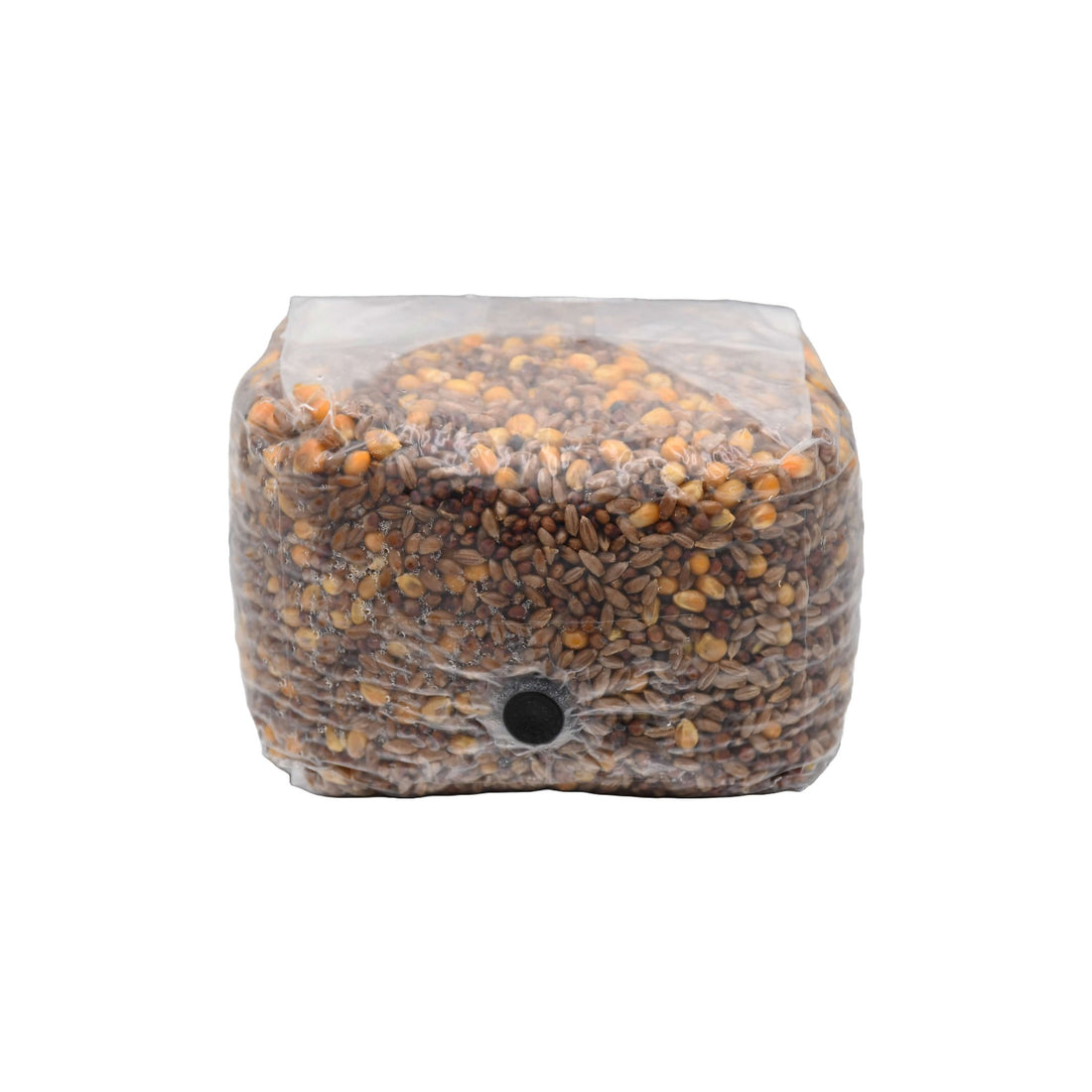
How to Use Multi Grain Mushroom Substrate Bag - 3lb
Share
How to Use Multi Grain Mushroom Substrate Bag - 3lb
Setting Up a Clean Workspace
Before working with the Multi Grain Mushroom Substrate Bag - 3lb, it’s essential to create a clean and sanitized environment to prevent contamination. Using a laminar flow hood or still air box is ideal, but if you don’t have access to these, you can still minimize contamination by following these steps:
- Disinfect your work area with rubbing alcohol or a similar sanitizing agent to remove dust and contaminants.
- Avoid working in areas with airflow from fans, air conditioners, or heaters, as these can introduce airborne contaminants.
- Wipe down the substrate bag with rubbing alcohol before handling it to ensure a sterile surface.
- Sanitize your hands and tools, such as scissors or syringes, before working with the substrate.
Maintaining a clean workspace is critical to the success of your inoculation process. If you don’t have a laminar flow hood, consider using a still air box to limit airborne contamination during the procedure.
Inflating the Substrate Bag
The Multi Grain Mushroom Substrate Bag - 3lb is fully hydrated and sterilized, but before inoculating, it’s important to slightly inflate the bag to ensure proper gas exchange through the 5-micron filter patch. This helps the mycelium colonize evenly throughout the substrate. Here’s how to prepare the bag:
- Grasp the opposite gussets of the bag and gently pull them apart, allowing air to enter through the filter patch.
- Repeat this process until the bag is slightly inflated and ready for inoculation.
Inoculating the Multi Grain Substrate Bag
1. Prepare Your Grain Spawn
Before inoculating the Multi Grain Substrate Bag, you’ll need to prepare colonized grain spawn. This can be done by inoculating grain jars or grain bags with liquid culture or spores and allowing the grains to fully colonize over several weeks.
2. Sterilize the Syringe Needle
Flame sterilize your syringe needle by holding it over a flame until it turns red hot. Let the needle cool for 30 seconds to 1 minute before proceeding with the inoculation. This process ensures the needle is free of contaminants.
3. Inject the Colonized Spawn
Insert the cooled needle into the self-healing injection port of the substrate bag. Inject 4-6cc of spore solution or liquid culture into the bag, spreading the inoculant evenly to promote uniform colonization.
4. Mix the Substrate
After inoculating, gently massage the bag to distribute the inoculant evenly throughout the grains. This ensures that the mycelium spreads uniformly, which helps speed up the colonization process.
Incubating the Multi Grain Substrate Bag
Once inoculated, place the substrate bag in an upright position in a room-temperature environment (65-75°F). Be sure to keep the bag away from direct sunlight or areas where temperatures fluctuate frequently. The substrate can be incubated at up to 80°F, but avoid going higher to prevent stalling the mycelium’s growth.
It’s important to ensure the 5-micron filter patch remains unobstructed during incubation, allowing for proper gas exchange. You should begin to see mycelial growth within 10-14 days, with full colonization typically occurring in 3-4 weeks when using spores. Liquid culture tends to reduce this time by about a week.
Fruiting or Using as Spawn
Once the substrate is fully colonized, you have two options:
- Fruiting in the Bag: You can fruit the mushrooms directly inside the bag. Open the bag daily to allow fresh air exchange and maintain high humidity by misting the substrate lightly. Monitor the mushrooms as they develop, and harvest them just before the caps fully open to prevent spore release.
- Using as Spawn: Alternatively, you can use the colonized substrate as spawn by transferring it to a secondary bulk substrate such as manure or wood-based substrates. This provides additional nutrients for the mushrooms, resulting in larger flushes. Break up the colonized substrate gently before mixing it into the secondary substrate.
Monitoring for Contamination
Although the Multi Grain Substrate is fully hydrated and sterilized, contamination can still occur if the environment isn’t properly controlled. Be vigilant for unusual colors, slime buildup, or foul odors, as these are signs of contamination. If contamination is detected, discard the affected substrate and thoroughly sanitize your workspace before starting a new batch.
Maximizing Yield
To maximize your mushroom yield, focus on maintaining proper environmental conditions throughout the colonization and fruiting stages. Ensure the substrate has sufficient gas exchange by keeping the filter patch unobstructed, and monitor the humidity levels closely during fruiting to avoid drying out or over-saturating the substrate.
If you’re using the Multi Grain Substrate Bag as spawn, consider pairing it with a nutrient-rich bulk substrate like manure or wood to provide the mushrooms with more nutrients, allowing for larger and more abundant flushes.
Conclusion
The Multi Grain Mushroom Substrate Bag - 3lb provides a versatile and nutrient-rich medium for growing mushrooms. Whether you choose to fruit directly in the bag or use it as spawn for a secondary substrate, following these steps will help you achieve healthy, robust mushroom growth. With the right care, you can enjoy multiple flushes from your substrate and optimize your yield.
